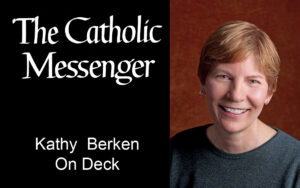 By Kathy Berken
By Kathy Berken
I have attended more retreats than I can count where I walk in and on a long table is a variety of craft items: paper plates, feathers, beads, string, ribbon, magazines, buttons, scissors, colored pencils, construction paper and glue. Over the years, whenever I saw these displays, I became increasingly frustrated with the art project I knew was going to be part of the retreat. I’m just not an artist; I prefer writing to drawing. Even though I still participated in the art project, I never could get into it.
However, the idea of doing art on a retreat changed when I came across the book, “Praying in Color: Drawing a New Path to God,” by Sybil MacBeth (Paraclete Press 2019). An edition for children is also available. (Disclaimer: I have no connection to the book’s author or publisher.)
As a retreat leader, I look for activities that engage the whole person. That’s why I love the labyrinth. It’s a physical prayer that requires only that you walk the path and pay attention to your body.
Praying in Color is like walking a labyrinth, but instead of moving your feet, you move your hands. As praying with the labyrinth is not about walking but about experiencing your body moving along circuits, praying with color is not about art, but about experiencing your hands holding a pencil moving along a piece of paper. You don’t have to think about what words (if any) to use or whether your words are appropriate, holy enough or long enough. You are allowing your body to pray for your mind.
Although MacBeth describes several different scenarios for praying in color, all have a common element: moving your pencil on a piece of paper or doodling with a purpose. One process that works well with a group of people is “Praying for Others.” Seated at tables with plain copy paper and colored pencils or pens, the facilitator opens with a short prayer and then asks the group for different names for God. Each person writes a word or phrase of their choosing in the center of the paper and encircles it with any shape. Decide how many people the group wants to pray for, estimating about five minutes for each.
The leader starts the process, asking the group, for example, to pray for Mary who has COVID-19. Allowing room for the other four people on the page, we all write Mary’s name and then use the next five minutes to prayerfully doodle — drawing lines, shapes, figures, anything. We just pay attention to the fact that we are all, at the same time, praying for Mary without using words.
The leader rings a chime and asks for another name with a brief description. The process of “doodle-prayer” continues until we have prayed for all five people. The leader ends with a short closing prayer. At this point, the group might want to share how the experience felt, and how it might have been different for them from traditional prayers of petition.
MacBeth’s book has pages of sample doodle-prayers as a way of jump-starting the process, along with chapters on using color to pray specific kinds of prayers, such as “Gratitude or Gruntled Prayers,” “Daily Inventory Prayer/The Examen,” “Blessing Prayers” and prayers for liturgical seasons, praying with Scripture.
I found many YouTube videos by various religious educators and pastoral ministers who use this process with their groups. You can also pray in color by yourself. There is no right or wrong way to pray if your intention is to communicate with God. Even if you think art is not your thing, I encourage you to try Praying in Color as an option to become more aware of the presence of God in your life.
(Kathy Berken is a spiritual director and retreat leader in St. Paul, Minnesota. She lived and worked at L’Arche in Clinton — The Arch from 1999-2009.)











